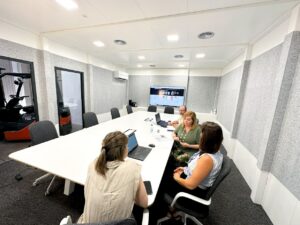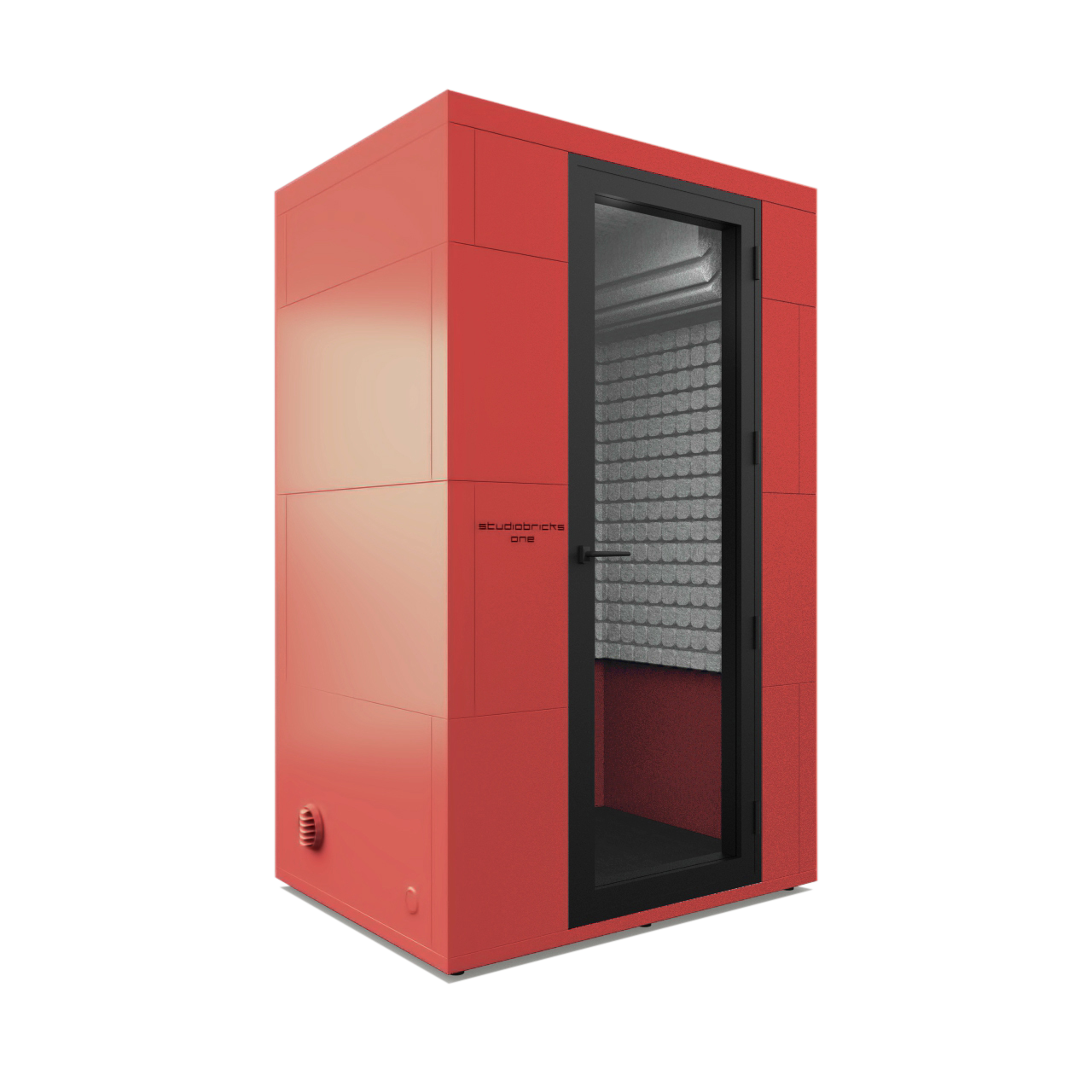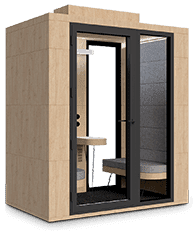Organizations all around the world have been compelled to reconsider and revamp their operational procedures in the wake of the pandemic. The era of the hybrid work model, which combines in-office and remote work, has begun, replacing the conventional office setup as the norm. Achieving a balance between focused attention on oneself and productive teamwork has never been more important, especially as businesses are now requesting that employees return to their offices while still retaining flexibility.
As the hybrid work model becomes more prevalent, so does the need for strategies to enhance its effectiveness. Let us look at six strategies that businesses can use to maximize the benefits of their hybrid work model.

1. Clear Communication Protocols
In a time when offices are changing, it is essential to communicate clearly and consistently. Setting up good communication rules is important for bridging the geographical gap in remote and hybrid work models, as many professionals have pointed out on sites like LinkedIn. The essence of this lies not just in the frequency of communication but, more importantly, in its clarity, consistency, and inclusivity.
The team at Simera highlights the importance of setting communication norms. Whether it’s defining which channel to use for specific types of communication, setting response time expectations, or ensuring that all team members are on the same page, setting these norms early on prevents confusion and miscommunication. Implementing daily or weekly check-ins, using dedicated channels for different types of communication, and scheduling regular team meetings can enhance the team’s cohesion.
Visual communication has also emerged as a powerful tool for remote teams. As discussed in TechSmith’s, using visuals can simplify complex ideas, provide clarity, and foster a deeper understanding. Visual aids, whether they’re infographics, videos, or simple annotated screenshots, can often convey what words alone cannot.
Furthermore, Timely suggests that structured communication inspires meaningful engagement from teams, which improves the quality of interactions. Platforms like Slack or Zoom can be compartmentalized to serve various functions: some for casual team chats, others for project-specific discussions, and separate spaces for brainstorming or feedback. This structured approach ensures that information is easily accessible and not lost in a sea of messages.
Also, while useful tools for online communication are important, the place from which we talk is just as important. Silence plays a pivotal role in enhancing clarity during virtual interactions, such as Zoom calls. Background noise, interruptions, or feedback can hinder the communication process, making meetings longer, less productive, and causing more fatigue for team members. This is where the physical workspace comes into focus. Offices, recognizing the importance of undisturbed communication, should consider investing in dedicated meeting rooms or phone booths. These spaces, isolated from the usual hustle and bustle of an office environment, ensure that every word spoken is heard clearly, and every point made is understood fully. It’s a testament to the saying, “Silence is golden,” especially in the realm of hybrid work models.
In conclusion, as hybrid work models become the norm, the foundations of effective team collaboration lie in clear, structured, and visual communication. Organizations that invest time and resources into developing and maintaining robust communication protocols will undoubtedly witness increased productivity and team satisfaction.

2. Flexible Work Hours
There is a clear trend toward more flexible work arrangements in the workplace these days. A guide by RingCentral showcases the plethora of benefits linked to flexible work hours. From higher job satisfaction and reduced commute times to improved mental well-being and enhanced productivity, the benefits are undeniable. A flexible approach allows employees to align their work schedules with their most productive hours, ensuring that the output is of the highest quality.
However, it’s not without its challenges. As Quantic points out, the key to making hybrid work a success is finding the right balance between individual productivity and team collaboration. While it’s commendable to allow individuals the freedom to choose their working hours, it poses the challenge of synchronizing team meetings, brainstorming sessions, and collaborative endeavors. The most important thing is to set core hours when everyone can work, which will help the team work together while still allowing for some flexibility.
Wrike’s guide further elaborates on the importance of crafting a well-defined flexible work policy. This involves outlining the expectations of employees, determining how performance will be measured, and ensuring that the right tools and resources are available for seamless remote work. A clear policy not only aids in maintaining consistency but also instills a sense of responsibility among team members.
However, while technology has made flexible work feasible, the physical workspace still plays a crucial role. Although allowing individuals the freedom to work during their peak productive times is highly beneficial for individual output, it can create hurdles for collective teamwork. This highlights the significance of designing offices with a human-centric approach. Spaces that encourage teamwork are critical for realizing a team’s full potential. Creating an environment where collaboration is not only possible but also efficient and productive ensures that team members look forward to these collaborative sessions, allowing them to make the most of this golden era of hybrid work.

3. Invest in Training and Development
In the evolving landscape of hybrid work, training and development assume a pivotal role. According to Benjamin Franklin, “An investment in knowledge pays the best interest.” This sentiment resonates even more in today’s complex work environment. In his book “The Fifth Discipline,” Peter Senge underscores the idea of the “learning organization”—one where people continuously expand their capacity to create the results they desire. Senge asserts that in such organizations, new and expansive patterns of thinking are nurtured, and collective aspiration is set free. Training and development, thus, aren’t just about skill acquisition; they’re about fostering a mindset of continuous growth and adaptability.
Furthermore, a research paper by Pfeffer and Sutton titled “Evidence-Based Management” emphasizes the importance of making decisions based on a combination of critical thinking and the best available evidence. This suggests that for employees to remain effective in a hybrid work model, they need not just training in their respective roles but also guidance on evidence-based decision-making processes. Articles such as Forbes’ piece on employee development elucidate how consistent training can lead to higher employee satisfaction, increased loyalty, and enhanced company reputation. When companies invest in their workforce’s professional growth, it sends a powerful message of trust and belief in their potential, making them feel valued and motivated to contribute their best.

4. Embrace Digital Collaboration Tools
In a hybrid work environment, the tools we use can make or break the seamless integration of on-site and remote work. Jacob Morgan, in his book “The Future of Work,” delves deep into how the right technology can drive engagement, innovation, and strengthen company culture. He contends that the success of a hybrid work model heavily depends on the caliber of digital tools at its disposal. With many companies saving money by not maintaining physical seats for every employee at the office, it’s imperative that these financial resources are redirected towards the acquisition and implementation of top-tier digital collaboration tools.
A pivotal research paper by Hossain, Wu, and Chung in the “Journal of Computer-Mediated Communication” explores the dynamics of digital collaboration in depth. The paper emphasizes the importance of digital tools in improving collaborative efforts, reducing misunderstandings, and streamlining processes in geographically dispersed teams. The efficacy of a hybrid model does not just lie in flexibility or policy; it’s equally about equipping teams with the right tools to communicate, collaborate, and create. Articles in renowned publications like the Harvard Business Review echo a similar sentiment, urging companies not to skimp on investing in high-quality digital collaboration platforms.
Basically, for a hybrid work model to really take off, companies need to put a lot of money and time into tools that connect the real and virtual worlds. These tools should make sure that operations run smoothly and help teams work together.

5. Set Clear Boundaries and Prioritize Mental Well-being
In the hybrid world of work, the intertwining of professional and personal spaces has brought about both conveniences and challenges. Cal Newport, in his critically acclaimed book “Deep Work,” emphasizes the importance of deep, uninterrupted focus in enhancing productivity and creativity. Newport champions the idea of setting clear boundaries to achieve such focus. Even though it can be alluring to combine the conveniences of home life with the obligations of the workplace, doing so without making clear distinctions can undermine the sacredness of each domain. Dedicated work hours, regular breaks, and a specific workspace not only foster productivity but also protect personal time, allowing individuals to rejuvenate and maintain a work-life balance.
However, just as boundaries are crucial, so is the mental well-being of employees. The melding of work and home, while efficient, can inadvertently lead to extended work hours and the feeling of being ‘always on.’ Dr. Christina Maslach, a leading researcher on burnout, notes in her various papers that the lack of clear work-life differentiation can be a significant factor in employee burnout. Organizations, therefore, have a responsibility to ensure that their employees are not just productive but also mentally sound. Access to mental health resources, promoting a culture that values breaks, and emphasizing the importance of switching off’ from work are paramount.
Several articles, like those from the Harvard Business Review, reiterate that the responsibility of ensuring well-being lies not just with the individual but also with the organization. In the hybrid work landscape, the need for setting boundaries and prioritizing mental health is not a luxury; it’s a necessity. Companies that recognize and act upon this are not only ensuring the well-being of their workforce but are also investing in the long-term success and resilience of their organization.

6. Dedicated Spaces for Team Work: The Studiobricks Solution
While all the above strategies are essential, the need for dedicated spaces for teamwork cannot be understated. The landmark book “The Third Place” by Ray Oldenburg emphasizes the importance of spaces that aren’t home or work but serve as essential communal areas. Such spaces facilitate spontaneous and structured interactions that foster innovation. As teams come together a few times a week to discuss innovations or even sensitive issues, having a conducive environment modeled on this concept becomes imperative.
This is where solutions like Studiobricks’ meeting rooms come into play. By taking ideas from Oldenburg and combining them with modern architectural knowledge, these specially designed booths create a private, quiet space that helps people have focused conversations without the usual office distractions. A feature in the Wall Street Journal highlights the rising trend of phone booths and dedicated spaces in offices, pointing out their importance in today’s changing work dynamics. They serve as a testament to the importance of having dedicated spaces in the age of the hybrid work model.
Moreover, in the context of the ‘new work’ concept and the changing dynamics of work, having such spaces isn’t just a luxury but a necessity. In his seminal article, “The New Ways of Working,” Jeffrey Joerres talks about the transformations workplaces have undergone and how spaces play an instrumental role in shaping work cultures and productivity. These dedicated spaces, as described by Joerres, encapsulate the essence of the hybrid work model, providing an environment where individual concentration and effective team collaboration can co-exist.
Conclusion
The hybrid work model is here to stay. As the lines between traditional office setups and remote work blur, it’s crucial for organizations to evolve. By implementing these 6 strategies, companies can ensure they not only stay relevant but also provide an environment where their teams can thrive both individually and collectively. Whether it’s embracing digital tools, focusing on mental well-being, or investing in dedicated spaces like Studiobricks’ meeting rooms, every step taken towards improving the hybrid work model’s effectiveness is a stride towards a more productive, satisfied, and engaged workforce. Explore more at https://porch.com/advice/hybrid-workplace. Our New Work expert, Ina Scherbaum, shares insights on design elements enhancing productivity in coworking environments.


















